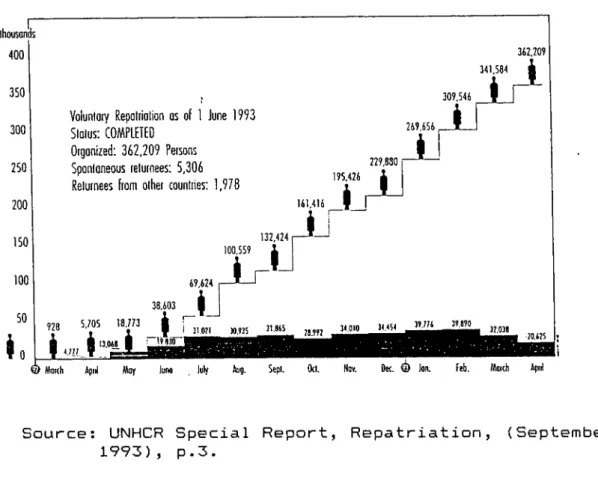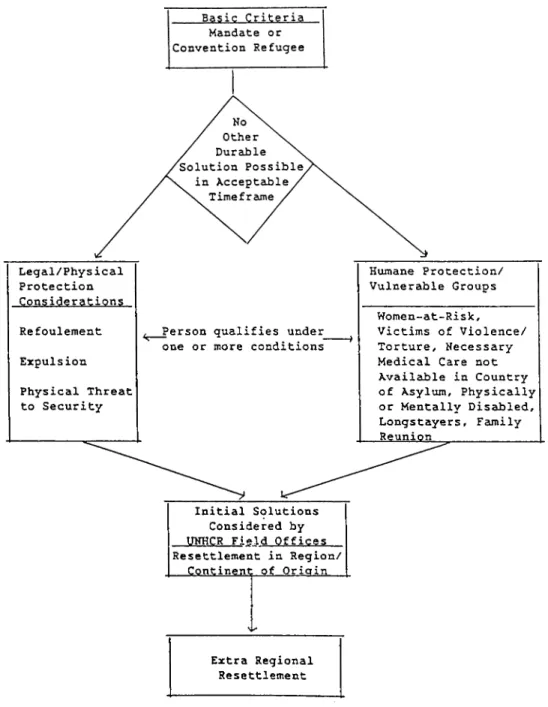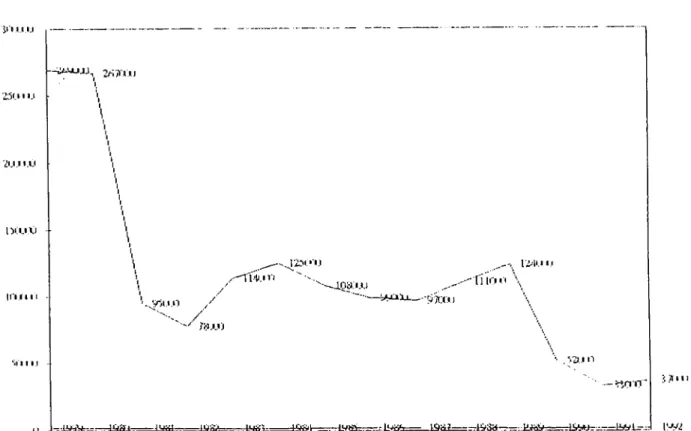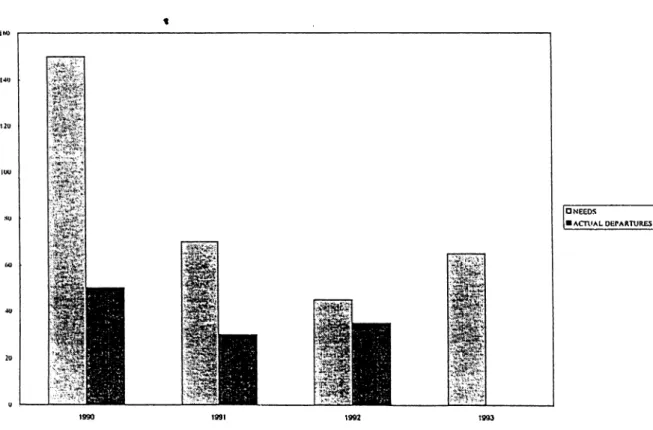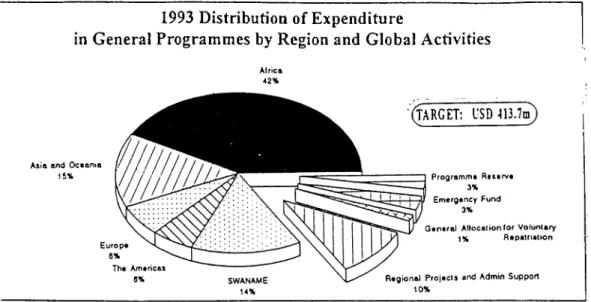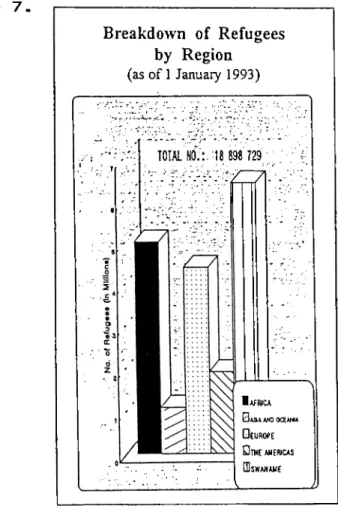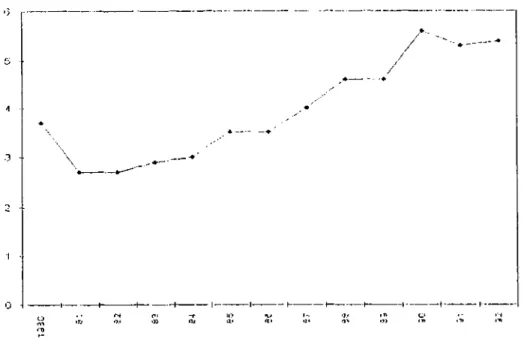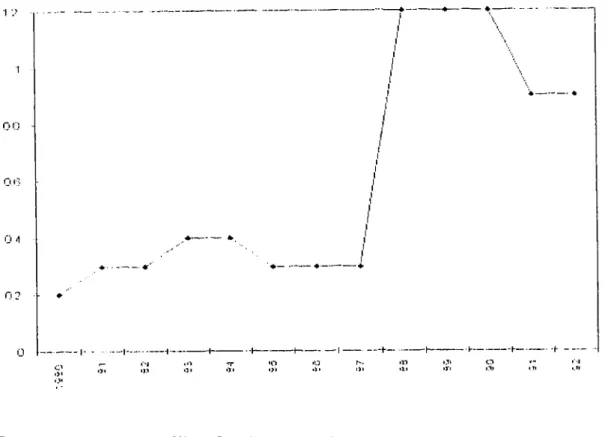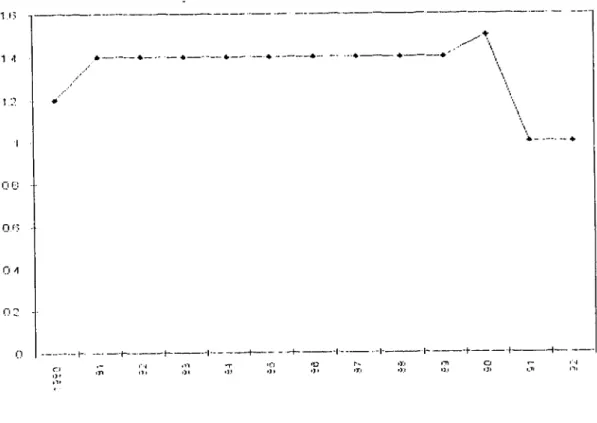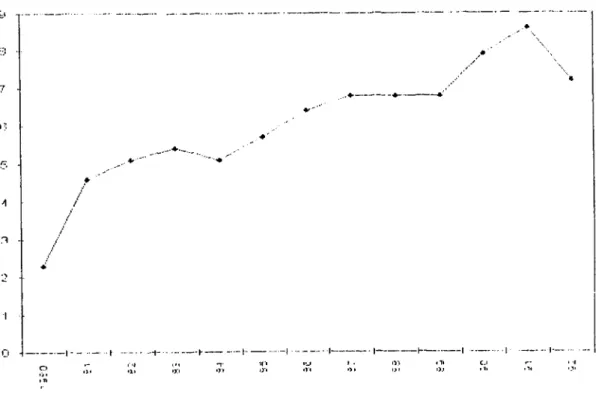<1 Π t·; " H v
INTERNATIONAL PROTECTION OF REFUGEES: THE PRACTICE OF UNHCR
A Thesis
Submitted to the Faculty of Economic, Administrative
and Social Sciences of Bilkent University
In Partial Fulfilment of the Requirements for the Degree of
Master of Arts in International Relations by Cenan ÇARMAN Bilkent University June 1994 -„ .C e a c in .... y _
I certify that I have read this thesis and in my opinion it is fully adequate, in scope and in quality, as a thesis for the degree of Master of Arts in International
Relations-Asst- Prof- Gülgün Tuna
I certify that I have read this thesis and in my opinion it is fully adequate, in scope and in quality, as a thesis for the degree of Master of Arts in International Relations.
I certify that I have read this thesis and in my opinion it is fully adequate, in scope and in quality, as a thesis for the degree of Master of Arts in International Relations.
ABSTRACT
This study aims to analyze UNHCR's practice pursued since 1950 for the protection of refugees. A review of previous organizations and legal instruments is given in order to find out the meaning of the term " refugee " until the establishment of UNHCR which is considered to be a successor to all these organizations. The procedure and criteria applied by UNHCR for the eligibility determination of refugees are examined with the aim of identifying the group of asylum-seekers which are under the mandate of UNHCR. UNHCR's protection functions which involve promoting legal tools to secure the rights, security and welfare of refugees, and finding solutions either by voluntary return of refugees to their country in conditions of security, or by assimilation in a new national community are examined-
Finally, the changing role of UNHCR in the post-Cold War era is evaluated and new strategies are suggested in the concluding chapter.
□ ZET
Bu çalışmanın amacı, 1950'den bu yana uluslararası platformda yer alan Birleşmiş Milletler Yüksek Komiser1 iği'nin dünya mültecilerine sağlamakta olduğu korumanın incelenmesine yöneliktir.
Mülteci terimine verilen tanımın anlaşılmasi için bu örgütün kurulmasına dek işlevlerini sürdürmüş ve bu terime değişik anlamlar vermiş olan diğer uluslararasi örgütler ve hukuki kaynaklar incelendikten sonra Komiserliğin geliştirmiş olduğu uygulama ve bu çerçevede mülteci tanımını oluşturan kriterler tezin temelini oluşturmaktadir. Bu tanıma uyan mültecilere Birleşmiş Milletler Yüksek Komiser1 iği'nin sağlamis olduğu hukuki korumayı ve onlar için geliştirtiği somut çözümleri araştirmak tezin ana hedefidir. Buna paralel olarak tezin son bölümünde, değişen dünya konjüktürü göz önünde tutularak. Soğuk Savaş sonrası Yüksek Komiserliğin işlevliği tartışılmakta ve yeni dinamiklere uygun stratejiler öneriİmektedir.
I have started working over this thesis and finished it during a period of my life when I met great people who taught me what a real friendship, merely what a human relation means. UNHCR Ankara BO helped me to gain a professional spirit which shall make valuable contributions for the success of my tasks in the future, at the same made me understand the high values that a human nature should pursue. Now, I am stronger to struggle with the challenges and achieve successes in my future. I will not forget any minute of mine at UNHCR and I am grateful to every single individual there who have given their full psychological support to me to finish this thesis. I love my family at UNHCR Ankara BO.
I also would like to express my gratitude to my Professor Gülgün Tuna who initially motivated me and who eased every hard minute for me by her academic discipline and her matured personality. I am grateful for her patience and for all kind of support she has given to me to finish my study.
I must also thank my family who have tolerated me during my studies at home and who have always provided to me their moral support and my friends, Ayşegül Somunkiran and Alev Pak who have never hesitated to help me at any minute.
Cenan SARMAN ACKNOWLEDGEMENTS
TABLE OF CONTENTS
ABSTRACT ... i
QZET ... ii
ACKNOWLEDGEMENTS ... iii
TABLE ÜF CONTENTS ... iv-v LIST OF FIGURES AND MARS ... vi
1. INTRODUCTION ... 1
2. THE FOUNDATIONS OF INTERNATIONAL PROTECTION... 5
2.1 Refugees defined in International Instruments and Arrangements adopted between the Two World Wars ... 5
2.2 Refugees from the perspective of the United Nations... 10
2.3 Refugee Definition in the 1951 Convention... 17
2.4 Development of the Statutory Definition and Extension of the Mandate ... 18
2.5 1967 Protocol Relating to the Status of Refugees ... 21
2.6 Regional Instruments Relating to the Status of Refugees ... 23
3. DETERMINATION OF ELIGIBILITY FOR REFUGEE STATUS... 27
3.1 Who Decides Eligibility? ... 27
3.2 General Principles ... 29
3.3 Inclusion Clauses ... 30
3.4 Cessation Clauses ... 41
3.6 Special Cases ... ... ... 52
3.7 The Principle of Family Unity ... 54
4. THE FUNCTIONS OF UNITED NATIONS HIGH COMMISSIONER FOR REFUGEES ... 57
4.1 UNHCR's Mandate ... 57
(a) Legal Protection of Refugees ... 61
(b) To Locate a New Home: Three Durable Solutions Promoted by UNHCR ... 68
(i) Voluntary Repatriation ... 69
(ii) Local Integration ... 76
(ii) Third Country Resettlement ... 77
4.2 Protection in Times of Refugee Emergencies ... 84
4.3 UNHCR General Programmes ... 87
5. THE CHANGING ROLE OF UNHCR: ITS NEW STRATEGIES .... 101
APPENDIX ... 116
NOTES ... 124
LIST OF FIGURES AND MAPS
F igures:
Figure 1 UNHCR Cambodia Repatriation 1992-93 ... 75
Figure 2 Determinants for Pursuing Resettlement As A Durable Solution ... ... 78
Figure 3 UNHCR Global Resettlement ... 81
Figure 4 Shortfall of Resettlement Places in 1990, 1991 and 1992 ... 83
Figure 5 Numbers Accepted for Resettlement, by Receiving Countries ... 84
Figure 6 1993 Distribution of Expenditure in General Programmes by Region and Global Activities ... 88
Figure 7 Breakdown of Refugees ... 89
Figure 8 Numbers of Refugees in Africa ... 90
Figure 9 Numbers of Refugees in Latin America ... 91
Figure 10 Numbers of Refugees in North America ... 92
Figure 11 Numbers of Refugees in Asia ... 93
Figure 12 Numbers of Refugees in Ocenia ... 93
Figure 13 Numbers of Refugees in Europe ... 94
Figure 14 Global Refugee Numbers 1960 - 92 ... 109
Maps; Map 1 Refugees by Country of Asylum in Africa ... 96
Map 2 Refugees by Country of Asylum in the Americas and the Carribean ... ... 97
Map 3 Refugees by Country of Asylum in Asia and Ocenia ..98
Map 4 Refugees by Country of Asylum in Europe ... 99
1. INTRODUCTION
There have probably been refugees as long as mankind exists but international action on behalf of them in defining their legal status,in extending to them international protection ; in seeking,in a co-ordinated manner, solutions for refugee problems is relatively recent (1).
Legal formulations of refugee status are a product recent Western history. Prior to this century, there was little concern about the precise definition of a refugee since most of those were readily received by rulers in Europe and elsewhere and this sheltering was perceived as a necessary incident of power (2).
But by the twentieth century has come, immigration as Goodwin Gill notes has come to be seen less as a means of allowing individuals to exercise their right to self- determination, then rather as a vehicle to facilitate the selection by states of new inhabitants who could contribute in some tangible way, such as skill or wealth, to their national-being (3). The idea that refugee problems should be the concern of the international community and should be resolved in the context of international solidarity came up after the First World War when countries, mainly in Europe and the Middle East but also in the Far East, were faced with refugee problems as a consequence of the collapse of the Ottoman Empire and of the revolution in Russia. With the disintegration of the Ottoman Empire with its multiplicity of ethnic, linguistic and religious groups, each seeking to
establish its claim to a national territory, refugees fled ever more horrific massacres. Jews, Assyrians, Armenians, Chaldenians, Turks, Serbs and Macedonians fled from the advances of each other's armies. Besides, the Russian Revolution and its aftermath led to the flight of over a million refugees over the changing Soviet borders between
1917 and 1921 (4).
Finally, the European states were convinced that their laws would have to recognize the reality of forced international movements of people (5). Governments had to find ways of working together to address refugee and displaced persons that outstripped the capacity of individual states (6). So starting from the early twentieth century, the need to provide for a specific system of protection of the refugee has gradually led to the present international protection system. And the world recorded an estimated 18.2 million refugees in 1993 which in 1970 there were only 2.5
million, and 11 million ten years ago.
The origin of the international concern for refugees is to be found in the fact that the refugee is an unprotected alien, in the absence of the usual consular and diplomatic protection which aliens may claim from the state of their nationality. The need to provide a substitute for such protection is a fundamental element of the refugee concept. Therefore, there is a very close link between the international legal concept of refugee and that of international protection (7). Gilbert Jaeger defines
" international protection " as a series of arrangements with institutional and legal aspects meant to provide for the specific position of a refugee as an alien resident who cannot claim the protection of his country of nationality and to ensure for the refugee in the country of asylum a status as close as possible to the status of national
residents, particularly with respect to civil, economic, social and cultural rights.
My main purpose in this thesis is to focus on the " international protection " of the refugees by the office of UNHCR and on the " durable solutions " provided by this office for their protection.
My starting point is a presentation of all the international instruments and organizations for the protection of the refugees since the end of the First World War, that is, the foundations of the international protection so as to grasp the historical development of the term
" refugee " in International Law. In this review of historical background, I will follow a chronological order of analysis by examining the status of refugees under each instrument and organization.
In the second part, the emphasis will be on the procedure applied by UNHCR for the determination of the refugees, by pointing out the four criteria being applied under the UNHCR's Statute so as to understand the category of refugees which are the concern of the Office of UNHCR.
This second part will be followed by a chapter presenting the UNHCR Protection Functions provided to the
refugees in its concern. Légal protection will be one subtitle that will be examined and the three durable solutions that are within the mandate of UNHCR will be another.
In a concluding chapter, I will try to assess the UNHCR's work in the post-Cold War era in dealing with the world refugee problems and discuss the new strategies that can be pursued by this office in the 1990s by presenting different perspectives on this issue.
2. THE FOUNDATIONS OF INTERNATIONAL PROTECTION
2.1 Refugees Defined in International Instruments and
Arrangements Adopted between the Two World Wars
As from the end of the First World War, international legal instruments were adopted in order to regulate various matters connected with new refugees as and when they arose. At the same time, international agencies were established for the legal protection of refugees. The international legal instruments relating to refugees adopted between the two World Wars form part of a general development in the field of
refugee law (1).
The refugee first attracted the attention of the international community in 1921, after the First World War. Faced with a wave of Russian refugees, certain European countries found it necessary to introduce a special legislation to overcome the problem created by the lack of identity papers, which made it impossible for many of these refugees to perform the most elementary acts of civil life
(marriage,contracts etc,) (2).
It was actually since 1921 that governments, mainly in the framework of the League of Nations, have created international agencies to undertake action on behalf of refugees. The history of international institutions of protection starts on 27 June 1921 when the Council of the League of Nations decided to appoint a High Commissioner for Russian refugees. Dr. Fridtrof Nansen was appointed to this post on 20 August 1921. His task was to define the legal status of refugees; to organize their repatriation or their
allocation " to countries which might be able to receive them and to undertake relief work (3).
The commissioner undertook a crusade which resulted eventually in a number of international agreements benefiting the various groups needing assistance at that time ( Russian, Armenian, Asyro-Chaldenian and Turkish refugees, and subsequently refugees from Germany and Austria ).
The first instrument was the Arrangement of 5 July 1922 which was specifically concerned with the issue of certificates of identity to Russian refugees (4). The Arrangement did not contain a definition of the term Russian " refugee " but the form of identity certificate annexed to the Arrangement described the holder as a " person of Russian origin not having acquired another nationality
The Arrangement of 31 May 1924 for the issue of identity to Armenian refugees was similar in type (5). These two arrangements were supplemented and amended by the Arrangement relating to the issue of identity certificate to Russian and Armenian refugees of 12 May 1926. Under this arrangement, a " Russian refugee " was defined as to include " any person of Russian origin who does not enjoy or who no longer enjoys the protection of the Government of the Union of Socialist Soviet Republics and who has not acquired another nationality An Armenian refugee was defined to include " any person of Armenian origin formerly a subject of the Ottoman Empire who does not enjoy or who no longer enyojs the protection of the Turkish Republic and who has not acquired another nationality " (6).
Then, this arrangement was extended to Turkish, Assyrian, Assyro-Chaldenian and assimilated refugees by the Arrangement of 30 June 1928. Assyrian or Assyro-Chaldean and assimilated refugees were defined as ” any person of Assyrian or Assyro-Chaldean origin, and also by assimilation any person of Syrian or Kurdish origin, who does not enjoy or who no longer enjoys the protection of the State to which he previously belonged and who has not acquired or does not possess another nationality Turkish refugees were defined as " any person of Turkish origin, previously a subject of the Ottoman Empire, who under the terms of the Protocol of Lausanne of 24 July 1923, does not enjoy or no longer enjoys the protection of the Turkish Republic and who has not acquired another nationality " (7).
These Arrangements of 1922, 1924, 1926 and 1928 were recommendations (8). The object of these treaties was initially to facilitate the freedom of movement of refugees, to create for refugees identity certificates or travel documents, which became to be known as " Nansen Passports "
(9) .
The first international instrument of relevance to the legal status of refugees was the Arrangement Relating to the Legal Status of Russian and Armenian Refugees of 1928 (10). This instrument was more comprehensive when compared with the previous instruments and contained recommendations dealing with expulsion, personal status, exemption from reciprocity and the right to work. It also recommended that the services normally rendered to nationals abroad by consular authorities
should be discharged by the representatives of the League of Nations High Commissioner for Russian and Armenian refugees
( 1 1) .
The next instrument adopted was the Convention of 1933 relating to the international status of refugees (12). It was also of a comprehensive character, and was the first legally binding treaty regulating the status of refugees- This treaty became a model for future international instruments in this field. Apart from regulating the issuance of refugee travel documents, the Convention dealt with a variety of matters affecting the daily life of refugees such as personal status, employment, social rights, education, exemption from
reciprocity and expulsion (13).
The new refugee problem that arose with the coming to power of Hitler led to the signing of the Provisional Arrangement concerning the Status of Refugees coming from Germany on 4 July 1936.
For the purposes of the Provisional Arrangement of 4 July 1936, the term " refugees coming from Germany " was defined by Article 1 as “ any person who was settled in that country who does not possess any nationality other than German nationality, or in respect of whom it is established that in law or in fact he/she does not enjoy the protection of the Government of the Reich " (14).
Jaeger argues that all these definitions can be termed as " pragmatic definitions " since they do not analyze the reasons for the refugee's departure from his country of origin and since they do not link refugee status with such
reasons or motivations. However, they indicate a kind of group determination of refugee status based on the events in the country of origin. They contain basically three elements: the national or ethnic origin; the lack of protection of the government of the country of origin; and the non-acquisition of another nationality (15).
According to Jaeger soon after there appeared a trend to include in the definition of refugee ideological elements, i.e the refugee is supposed to have left his country because his basic rights or his basic human rights were threatened (16). A first expression of this trend is to be found in the Convention concerning the Status of Refugees coming from Germany of 10 February 1938 which, in addition to the inclusion clause referring to nationality or geographical origin and lack of protection, contains an exclusion clause
formulated as follows: " Persons who leave Germany for reasons of purely personal convenience are not included in this definition " (17).
A few months later, in order to deal initially with refugees coming from Germany, an international conference, held at Evian in July 1938, established an Intergovernmental Committeee on Refugees, which was established outside the framework of the League of Nations. It contained the following definitions:
6 . (a) that the person coming within the scope of the activity of the Intergovernmental Committee shall be (1) persons who have not already left their country of origin ( Germany, including Austria ), but who must emigrate on account of their political opinion, religous beliefs or racial origin and (2) persons as defined in (1) who have already left their country of origin and
who have not yet established themselves
permanently elsewhere (18)
These are the international arrangements and instruments adopted during the period between the two World Wars on behalf of the refugees. Under these instruments and arrangements, internationa1 action on refugees was primarily aimed at establishing a legal status for refugees and at providing for a refugee passport. Only to a relatively limited extent, these institutions or organizations were meant to promote solutions to refugee problems and to provide material assistance to refugees which was more or less left
to the states and private organizations " (19).
2.2 Refugees from the Perspective of the United Nations
(a) United Nations Relief and Rehabilitation Administration (UNRRA) ( 1943 )
When the second World War ended, the world was faced with a problem of eight or ten million persons displaced during the war by the Axis Powers or who had otherwise been forced to leave their homes because of the war.
Already during the war, the United Nations Relief and Rehabilitation Administration (UNRRA) was set up early in November 1943 and dealt with assistance to and repatriation of millions of victims of the war, mainly displaced persons deported to Germany, Austria and other countries. It was set up with their resettlement as its main objective (20). However, UNRRA was not a specific refugee organization. By 1947 when the UNRRA was replaced by the IRQ, there were
(b) International Refugee Organization (IRO)
As soon as the United Nations organization was established, the problem of refugees was placed as an item of particular urgency on the agenda of the first session of the General Assembly and as early as 12 February 1946 the Assembly laid down the basic principles for UN action on refugees which are still valid today:
still over a million refugees in Europe.
(a) that the problem was international in scope and in character:
(b) that no refugees or displaced persons who had finally and in complete freedom expressed their objection to returning to their countries of origin should be compelled to return to that country;
(c) that the future of such refugees or displaced persons should become the concern of an international body to be established;
(d) that the main task concerning displaced persons was to encourage and assist in any possible way possible then early return to their countries
(2 1) .
In order to implement these principles, the General Assembly established the International Refugee Organization (IRO) which operated from 1 July 1947 to January 1952. The Constitution of IRO was an international treaty adopted by the General Assembly in Resolution 62 (1) of 15 December 1946. The Constitution of the IRO was an international treaty adopted by the General Assembly in Resolution 62 (1) of 15 December 1946.
elements in the definition is finally confirmed in December 1946 by the Constitution of the International Refugee Organization (22).
Like the pre-war instruments, the IRO Consitution defined refugees by specific categories.
(a) victims of the Nazi or fascist regimes which took part on their side in the second World War, or of the similar regimes which assisted them against the United Nations, whether enjoying international status as refugee s or not; (b) Spanish Republicans and other victims of the Falangist regime in Spain, whether enjoying international status of refugees or not (23).
The definition in the IRO Constitution also laid down certain broad criteria on the lines of a more general definition:
(c) persons who had been displaced from their homes as a result of events subsequent to the outbreak of the second World War and were unable or unwilling to avail themselves of the protection of the country of their nationality or former nationality for reasons of race, religion, nationality, or political opinion (24).
Thus, the IRO Constitution included the pre-war refugee categories and a new category. There was also the notion of " persecution " which was introduced not in the refugee
definition itself but in relation to
" valid objections " i.e. the conditions under which a person falling into an already defined refugee category became the concern of the organizations and entitled to claim its protection or assistance (25). These valid objections included:
(i) persecution, or fear, based on reasonable grounds of persecution because ofrace, religion, nationality or political opinions; (ii) and objections of a political nature, provided that these opinions were not in conflict with the principles of the United Nations laid down in the Preamble to the U.N Charter
(26) .
Jahn characterizes IRQ activities as follows:
(1) IRO was an intergovernmental organization in the form of a UN specialized Agency and not an organ of the United Nations.
(2) It was the first international agency dealing practically and comprehensively with all aspects of refugee problems
( registration, determination of status, repatriation and resettlement including transport and what they called " legal and political protection " ).
(3) Although repatriation was the primary task of IRO, relatively few went home and resettlement became the main objective of IRO. In fulfilling this task, IRO has set basic standards for dealing with large scale migration and has developed procedures and operational techniques which are still valid.
(4) During this first post-war period the international community realized that determined and coordinated efforts of states, with the help of an appropriate International Agency, could prevent refugees from becoming a permanent political, economic and social burden to countries of asylum and resettlement (27).
Consequently, from then on, every refugee would have to substantiate the fear he invokes by providing some proof
based on objective data and on the personal factors which make him fear persecution in the future, even if he has not been persecuted in the past (28).
(c) Birth of UNHCR and Its Statute
The work of the IRQ was drawing to a close since the problem of European refugees had not been completely resolved and since there was also a likehood that there would be other refugees for whom the same problems would arise.
It was, therefore, recognized that international action for the protection of refugees should continue and an organ with this responsibility should be established within the United Nations (29).
Upon the demise of the IRQ in 1949, the United Nations decided to take a direct responsibility for international action in favor of refugees. Two possibilities were open: either to entrust this task to a department of the UN Secretariat or to establish, within the administration and financial framework of the United Nations, an ad hoc body capable of acting independently (30).
On the proposal of the Secretary-General, the latter formula was adopted. So, the future body would remain as far as possible outside the political considerations with which the UN Secretariat had to deal, instead a UNHCR would have the independence, authority and prestige to enable him to intervene with Governments.
The decision to establish a High Commissioner's office for Refugees was taken by the General Assembly by its
resolution 319 (IV) of 3 December 1949. The main reason for establishing this office was " to promote the necessary legal
protection for refugees" (31).
The Statute of UNHCR was finally adopted as an Annex to General Assembly Resolution 428 (V) of 14 December 1950 (39). The Statute of UNHCR emphasized UNHCR's responsibilities to promote the legal protection of refugees and measures to reduce the number of refugees requiring protection (32).
The overall role of UNHCR is defined in Paragraph 1 of the Statute as " providing international protection " and " seeking permanent solutions ". Of paramount importance is also Paragraph 2, stating that " the work of the High Commissioner shall be of an entirely non-political character;
it will still be humanitarian and social ".
Chapter II of the Statute defines the competence of the High Commissioner. Paragraph 6 and 7 of the Statute dealing with this competence are usully referred to as the refugee definition of the Statute.
According to the relevant paragraphs of the Statute, 6 A (i), a refugee within the mandate of the High Commissioner is a person either already recognized as a refugee by earlier international agreements, or by the terms of the IRQ Constitution:
(i) Any person who has been considered a refugee under the Arrangements of 12 May 1926 and 30 June 1928 or under the Convention of 28 October 1933 and 10 February 1938, the Protocol of 14 September 1939, or the Constitution of the International Refugee Organization
According to paragraph B of Article 6 of the UNHCR Statute, the competence of the High Commissioner shall extend to:
Any other person who is outside the country of his nationality, or if he has no nationality, the country of former habitual residence, because he has or had well- founded fear of persecution by reason of his race, religion, nationality or political opinion and is unable or, because of such fear, is unwilling to avail himself of the protection of the government of the country of his nationality, or, if he has no nationality, to return to the country of his former habitual residence (34).
The UNHCR definition, largely inspired by that of the IRQ does not stipulate that a person must have become a refugee because of events occurring before a given date (35) ( See Appendix A ).
This new and long definition, contrary to the definitions used by the organization founded by the League of Nations which limited their mandate to precisely described and already existing categories of people, allows UNHCR to intervene at any time, and for any person, from wherever he comes, on the one condition that he fulfills its criteria
(36) .
But the High Commisssioner, practically speaking, is not an all-powerful judge status in the country where a person should be granted refugee status. That remains " a prerogative of governments ". They exercise it liberally on the whole, in conformity with the terms of the international conventions to which many of them have acceded, in particular to the Convention Relating to the Status of Refugees of 1951 and its Protocol of 1967 (37).
2.3 Refugee Definition in the 1951 Refugee Convention
During the preparatory work which lasted from 1947-50, the various United Nations bodies concerned drafted articles on a Convention relating to the legal status of refugees and stateless persons. This preparatory work was mainly in the framework of ECOSOC (Economic and Social Council).
In Resolution 248 (IX) B of 8 August 1949, the Economic and Social Council took note of the " Study of Statelessness" and appointed an ad hoc Committee consisting of representatives of 13 governments to consider the preparation of a consolidated Convention.
The Committee prepared a draft convention relating to the Status of Refugees and a separate draft Protocol relating to the Status of Stateless Persons (38). In Resolution 429 (V) adopted on 14 December 1950, the General Assembly decided to convene in Geneva a Conference of Plenipotentiaries to complete the drafting of and to sign the Convention relating to the status of refugees.
The Conference of Plenipotentiaries at which 26 states were represented by delegates met in Geneva from 2 to 25 July 1951. The Conference having considered the draft protocol relating to the status of stateless persons adopted the Convention relating to the Status of Refugees and a Resolution concerning stateless persons. The Final Act of the Conference was signed on 28 July 1951.
Though essentially the same with the Statute, the definition of the term "refugee" given by the Convention was
subject to two restrictions;
According to the Convention, the definition applies only to persons who entertain well-founded fear of persecution " as a result of events occurring before 1 January 1951 "; and further more these words could apply either to;
(a) " events occurring in Europe before 1 January 1951 " or to
(b) " events occurring in Europe or elsewhere before 1 January 1951 " (39).
So the Convention was subject to " dual restriction “, of time and place; apart from refugees who were already considered and regarded as such under earlier agreements, the Convention related only to those persons who had become refugees as a result of " events occurring before 1 January 1951 Moreover, governments had the discretion to apply the provisions of the Convention to persons who had become refugees as a result of events occurring " in Europe ", or as a result of events occurring " in Europe or elsewhere " (40)
( See Appendix B ).
This dual restriction, of time and place, was to remain until the 1951 Convention was amended by the Protocol of 1967. For, as new groups of refugees emerged, this restriction became more and more dicriminatory and unacceptable.
2.4 Development of the Statutory Definition and Extension of the Mandate
Early after the adoption of the 1951 Convention, it became obvious that there existed groups and categories of
persons who found themselves in a similar position to that of refugees, without necessarily meeting the criteria of the general definition. In some cases, these persons had left their country of origin for reasons other than those contained in the general definition, particularly war or civil war. These persons would not benefit from international protection (41).
It was in 1957 that the General Assembly first authorized the High Commissioner to assist refugees who did not come fully within the statutory definition (42). The case involved large numbers of mainland, Chinese in Hong Kong whose status as " refugees " was complicated by the existence of two Chinas, each of which might have been called upon to exercise protection (43). The High Commissioner was authorized " to use his good offices to encourage arrangements for contributions ". However, the action of the High Commissioner's Office had been strictly confined to a specific group, and had also been limited in scope (44).
On the occasion of the sudden and massive exodus of some 200,000 Hungarians in 1956 and of the Algerians to Tunisia and Morocco to escape the effects of the struggle for liberation, the General Assembly passed a resolution making a distinction for the first time between " refugees within the mandate " and " refugees who do not come within the competence of United Nations " , in respect of whom the High Commissioner was authorized to use his good offices in the transmission of contributions designed to assist them (45). Thus, the use of good offices was extended to group of
refugees not " within the competence of the United Nations " (46) .
In 1961, a new expression appeared. It reiterated in broader terms the notion of the High Commissioner's good offices. There was no longer any mention of " refugees who do not come within the competence of the United Nations ", nor " the use of good offices confined to transmission of
contributions. Hence, Resolution 1673 (XVI) of 18 December 1961 requested the " UNHCR to pursue his activities on behalf
\
of the refugees within his mandate or those for whom he extends his good offices ".
This particular good office procedure was resorted to by the High Commissioner in a series of new refugees situations - mainly in Africa - where it was considered impracticable or inappropriate to make a formal determination of refugee character under the Statute. These refugees were considered prima facie as falling within the 1950\51 definition " (47).
Thus, a concept of prima facie eligibility, prompted by events, gradually took shape. It deported from the individualistic concept linked to the definition of the term " refugee " in the Statute and Convention, and progressed towards a more pragmatic and humane rather than legalistic approach to the refugee problem " (48).
Prima facie eligibility was related to persons who
" being obliged by political events to leave their country and could reasonably fear for their security in the event of their being returned there are deprived of that country's
persecution. Prima facie eligibility is necessarily based on " objective " evaluation of the situation in the country (49) .
So the High Commissioner, in accordance with the objective criteria of prima facie eligibility, and with the agreement of the international community assisted various groups of persons whose security might be endangered if they were obliged to return to their country of origin, due to the political situation prevailing there.
The final integration of the High Commissioner's good offices and that of new groups of refugees, into the regular mandate was reached in 1965 by the General Assembly Resolution 2039 (XX). This resolution abandoned the distinction between refugees within the mandate and refugees covered by the High Commissioner's good offices (50). As from 1965, the relevant General Assembly resolutions no longer spoke of " refugees within the mandate and those for whom he extends his good offices " (51).
2.5 1967 Protocol Relating to the Status of Refugees
The 1951 Refugee Convention, with its restriction of time and geography was intended to address the problem created by the post-World War turmoils and the Cold War. The High Commissioner's mandate was originally set for three years and it was thought that the refugee crisis could be dealt with within a relatively short time (52).
growing number of refugee situations outside Europe, the need was soon felt to regulate the status of these new refugees in the same manner as it was done by the 1951 Refugee Convention. And the 1967 Bellagio Protocol relating to the status of refugees made the terms of the 1951 Convention applicable in new refugee situations.
The 1967 Protocol achieved the formal universalization of the Convention definition of refugee status. The obvious restriction in the Convention definition - the requirement that the claim relate to a pre-1951 event in Europe - was prospectively eliminated by the Protocol (53).
This Additional Protocol extends the application of the term " refugee " to any person corresponding to the definition given in the Convention of 1951, without time limit and without specifying a particular geographic zone (54) ( See Appendix C ). The Protocol extended the provisions of the Convention to post-1951 events and non-Europeans with the exception of the few signatory states which specified that they maintained the geographical limitation (55).
The 1951 Convention relating to the Status of Refugee as supplemented and made more relevant to modern conditions by its 1967 Protocol is considered " to be the major international instrument providing international protection to refugees " (56).
Article lA (2) of the 1951 Convention, as amended by the 1967 Protocol, provided that a refugee is a person who;
reasons of race, religion, nationality, membership of a particular social group or political opinion, is outside the country of his nationality and is unable or, owing to such fear, is unwilling to avail himself of the protection of that country; or who, not having a nationality and being outside the country of his former habitual residence is unable or, owing to such fear, is unwilling to return to it.... (57).
The initial requirement for a person to become entitled to the protection afforded by the Convention and Protocol is that;
first. the refugee must be " outside " of his or her country of nationality or habitual residence;
second, the acts and treatments from which the applicant is seeking refuge must qualify as " persecution ";
third, the refugee must have a " well-founded fear of persecution " and because of this must be unable or unwilling to rely on the protection of his or her country of origin;
fourth. the persecution feared must be due to one of, or a combination of, the enumerated reasons; race, religion, nationality, membership of a political social group, or
political opinion (58).
2.6 Regional Instruments Relating to the Status of the Refugees
(a) The Organization of African Unity Definition of Refugee Status
During the 1760s and 1770s, major refugee problems emerged in Africa. These problems stemmed from independence struggles and from efforts to establish national governments. By the end of 1763, there were some 400,000 African
refugees, principally Angolans and Rwandese. By the end of 1966, the number increased to more than 700,000 African refugees, including individuals from Sudan, the Congo and Portugese Guinea. By the end of 1972, the number increased again to more than 1 million, due mostly to new influxes from Ethiopia, Burundi and Equatorial Guinea (59).
But most of the African displaced persons did not satisfy the technical requirements of the legal definition of a " refugee " as recognized by the United Nations High Commissioner for Refugees (UNHCR). Also, these displaced persons fled into very poor countries that had extremely limited resources. Their ability to cope with these burdens was often limited by their already extreme poverty.
In 1969, the Organization of African Unity agreed to a Convention on Refugee Problems in Africa. The OAU significantly expanded on the International Covenant regarding the status of refugees. It included those persons who are outside their countries " owing to external aggression, occupation, foreign domination, or events seriously disturbing public order " (60).
Article II (2) of the Convention also states that granting asylum ’’ shall not be regarded as an unfriendly act " (61). It contains detailed provisions regarding asylum and voluntary repatriation of refugees. Of special note is the Article II (3) of the Convention which states that " no person shall be subjected by a member State to return or remain in a territory where his life, physical integrity or
So the 1969 African Convention being the first regional arrangement complements the 1951 Convention, the 1967 Protocol and the UNHCR Statute which established an international standard for the treatment of refugees firstly by the extension of the definition of a refugee, secondly by the inclusion of the principle of non-refoulment ( See Appendix D (A) ).
(b) The Organization of American States Definition of Refugee Status
The most recent extension of the refugee definition is derived from the Cartagena Declaration, adopted by ten Latin American states in 1984. Recognizing the inadequacy of the Convention definition to embrace the many involuntary migrants from generalized violence and oppression in Central America, the state representatives agreed to a refugee definition that is similar to that enacted by the Organization of African Unity (63). It defines " refugees " as follows:
...persons who have fled their country because their lives, safety, or freedom have been threatened by generalized violence, foreign agression, internal
conflicts, massive violations of human rights or other circumstances which have seriously disturbed public
order (64).
The OAS definition, unlike the OAU Convention, does not explicitly extend protection to persons who flee serious disturbance of public order that affects only part of their country, the claimant must be at risk due to the generalized
disturbance in her country so as to become a refugee". The OAS definition is a compromise between the Convention standard and the OAU conceptualization. It expands the " persecution " standard but also constrains the protection obligation under the QAU definiiton " (65) ( See Appendix D
(B) ) .
After this presentation of the international instruments and organizations relating to the status of the refugees, that is, the foundations of international protection concerning refugees, it can be concluded that the international assistance to refugees has steadily developed in scope and scale since its inception under the auspices of the League of Nations ( See Appendix E and F ). There has been a development in international legal instruments relating to refugees from the specific and limited to the more comprehensive and universal due to the political, technical, economic and social developments that have taken place in the world at an accelerated pace.
3. DETERMINATION OF ELIGIBILITY FOR REFUGEE STATUS
3.1 Who Decides Upon Eligibility ?
Refugee status, on the universal level, is governed by the 1951 Convention and the 1967 Protocol Relating to the Status of Refugees. These two international legal instruments have been adopted’ within the framework of the United Nations and they are applicable only to persons who are refugees as
therein defined (1).
102 states currently are parties either to the 1951 UN Convention on Refugees or its companion 1967 Protocol. The combined meaning of these legal instruments is that there is a sizeable agreement on the core of the definition of the term " refugee ", on the basic rules governing the treatment of such persons, and that the UNHCR should " supervise " the implementation of this international law (2).
The assessment as to who is a refugee, i.e. the determination of refugee status under the 1951 Convention and the 1967 Protocol, is incumbent upon the Contracting States in which territory the refugee finds himself at the time he applies for recognition of refugee status (3). But, the 1951 Convention and the 1967 Protocol provide for cooperation between the Contracting States and the Office of UNHCR for the determination of the eligibility of refugee status. This cooperation also extends to the determination of refugee status according to arrangements made in various contracting states (4).
The UNHCR Executive Committee has devoted considerable attention to the determination of refugee status. At its twenty-seventh session in 1976, the Executive Committee recommended that;
(c) the High Commission should continue to follow-up the implementation of the 1951 United Nations Convention and the 1967 Protocol relating to the Status of Refugee in various member States, including national practice and procedures for the recognition of refugee status
(5) .
The following year, the Executive Committee at its twenty-eighth session drew attention to the importance of procedures for determining refugee status and expressed the
hope that:
all States party to the 1951 Convention and the 1967 Protocol that had not yet done so should take steps to establish procedures for the determination of refugee status and give favourable consideration to UNHCR participation in such procedures in an appropriate form
(6) .
The Executive Committee at its twenty-eighth session also requested UNHCR to consider the possibility of issuing - for the guidance of Governments - a handbook relating to procedures and criteria for determining refugee status. So, in countries that are parties to the 1951 Convention and the 1967 Protocol, questions of eligibility are usually decided by the " competent authorities ", according to the procedures and criteria specifically established in the Handbook for this purpose (7).
Many national refugee status determination procedures provide for UNHCR participation in different forms, for instance as a sole decision-maker, or as a participant at
first, or as an observer/adviser, or as a participant at the appeal stage, or as a case reviewer of the rejected cases
(8) . UNHCR participation in the national procedures is of particular importance since UNHCR supervises the application of the 1951 Convention and the 1967 Protocol by monitoring both the procedures and criteria applied. UNHCR participation is also a guarantee for the purely humanitarian and non-political character of the determination procedure
(9) .
In states that are not parties to the Convention or Protocol, or which have not established refugee status determination procedures, UNHCR determines whether an applicant is a refugee within the terms of its mandate.
3.2 General Principles
A person is a refugee within the meaning of the 1951 Convention as soon as he/she fulfills the criteria contained in the definition. This necessarily occurs before refugee status is formally determined (10).
A person does not become a refugee because of recognition, but is recognized because he or she is a refugee.
Therefore, recognition of refugee status is declaratory, i.e stating the fact that the person is a refugee.
The provisions of the 1951 Convention defining who is a refugee consist of three parts, which have been termed as respectively " inclusion ", " cessation " and " exclusion " clauses (11)
Inclusion clauses define the criteria that a person must satisfy in order to be recognized as a refugee. These form the positive basis upon which the determination of refugee status is made.
Cessation and Exclusion clauses have a negative significance; the former indicate the conditions under which a refugee ceases to be a refugee. The latter set out the circumstances in which a person is excluded from refugee status, even though the positive criteria of the inclusion
clauses have been met (12).
3.3 Inclusion Clauses
According to Article 1/A (2) of the Convention, the term " refugee " shall apply to any person who:
...owing to well-founded fea reasons of race, religion, na particular social group or po the country of his national to such fear, is unwilling protection of that country; nationality and being outsid habitual residence as a resul or, owing to such fear, is
(13) .
r of being persecuted for tionality, membership of a litical opinion, is outside ity and is unable or, owing to avail himself of the or who, not having a e the country of his former t of such events, is unable unwilling to return to it
There are thus four main elements in the refugee definition: " well-founded fear ", " persecution ", " reasons of race, religion, nationality, membership in a particular social group or political opinion ", " outside the country of origin ".
Thus in order for a person to be qualified as a Convention refugee and to become entitled to the protections
afforded by the Convention and Protocol, he/she must satisfy the criteria within the Convention definition of the term " refugee ".
(a) " well-founded fear of persecution *' :
Paragraph 37 of the UNHCR Handbook on Procedures and Criteria for determining Refugee Status states that the phrase " well-founded fear of being persecuted " is the key phrase of the refugee definition (14).
So the core of the definition of the term refugee is " fear " ; " well-founded fear of persecution This requirement that the applicant for refugee status must have " a well-founded fear of persecution " contains both subjective and objective elements (15).
Fear is a state of mind, and is necessarily subjective. Therefore, the procedure of determining whether someone is a refugee requires an examination of the asylum-seeker's frame of mind. Paragraph 4 of the Handbook provides some guidance for the evaluation of the subjective element ;
It will be necessary to take into account the personal and family background of the applicant, his membership of a particular racial, religious, national, social or political group, his own interpretation of his situation, and his personal experiences - in other words, everything that may serve to indicate that the
predominant motive for his application is fear (16).
However, this does not imply that every asylum-seeker determined to fear of persecution is indeed a refugee. The point is that the fear must be well-founded. That is, the subjective element of fear is associated in the definition
with the words " well-founded ", and so an objective element is introduced (17). Fear is an entirely subjective state experienced by the person who is afraid- The adjectival phrase " well-founded " qualifies the subjective nature of the emotion- The qualification will exlude fears which can be dismissed as paranoid (18).
Immigration Appeal Board Decision on May 13, 1987 stated that:
.. subjective fear is capable of objective assessment: in other words, a person claiming refugee status must establish consistently, plausibly and credibly that specific events or designated persons intervened in his life so that there arose in him an almost irrepressible feeling of a physical or psychological threat against him or against his fundamental rights as a human being
(19) .
In Canada, Wilson, T. stated in the case of Kwiatkavsky
V M.E.I:
He may, as a subjective matter, fear persecution if he is returned to his homeland, but his fear must be assessed objectively, in order to determine if there is a foundation for it (20).
Lord Keith of Kinkel states that:
In my opinion, the requirement that an applicant's fear of persecution should be well-founded means that there has to be demonstrated a reasonable degree of likelihood that he will be persecuted for a convention reason if returned to his country (21).
Thus the refugee claimar^t need not show that his fear will be fulfilled but that it has a foundation, that is, he should support the subjective element of his fear with an objective
basis-(b) ■■ Persecution "
The well-founded fear must relate to persecution. Persons fearing famine or natural disasters are not refugees, unless they also have a well-founded fear of persecution for one of the reasons given in the definition (22).
There is no universally accepted definition of " persecution ". From Article 33 of the 1951 Convention, it may be inferred that " a threat to life or freedom on account of race, religion, nationality, political opinion, or membership of a particular social group is always persecution " (23). Paragraph 51 of the Handbook states that " other serious violations of Human Rights for the same reasons -would also constitute persecution “ . The Universal Declaration of Human Rights ( adopted and proclaimed by the UN General Assembly in 1948 ) lists the basic rights which constitute the integrity and inherent dignity of the
individual. These rights include:
freedom from torture, or cruel, inhuman or degrading treatment or punishment;
freedom from slavery or servitude;
recognition as a person before the law;
freedom of thought, conscience and religion; freedom from arbitrary arrest and detention;
freedom from arbitrary interference in private, home and family life (24).
The violation of these rights on account of race, religion, nationality, political opinion, or membership of a particular social group constitutes persecution (25).
Other Prejudicial Actions or Threats that may amount to Persecution :
prejudicial actions or threats may also amount to persecution (26). These other prejudicial actions or threats may include the following:
- punishment, or repeated punishment for a breach of law which is out of proportion with the offense committed. That is, a person guilty of a commom law offence may be liable to excessive punishment which may amount to persecution.
- Differences in the treatment of various groups will amount to persecution if the discrimination leads to
consequences of a substantially prejudicial nature for the person concerned, e.g. serious restrictions on his right to earn his livelihood, his right to practise his religion, or his access to normally available educational facilities (27).
- The economic restrictions may amount to persecution if they destroy the existence of a particular section of the population (e.g. withdrawal of trading rights from or discriminatory or excessive taxation of, a specific ethnic or
religious group).
- Severe penalties for illegal departure or unauthorized stay abroad may lead to persecution if the person can show that his motives for leaving or remaining outside the country are related to the reasons enumerated in Article 1 A(2) of the 1951 Convention (28).
Agents of Persecution z _
Paragraph 65 of the UNHCR Handbook notes that the persecution is normally related to action by the governmental authorities of a country. Although the state usually has
privileged access to the instruments of violence and persecution, it is not only states who indulge in acts that generate refugees. It may also emanate from sections of the population that do not respect the standards established by the laws of the country concerned (29). Armed population groups, such as the Shining Path in Peru, Renamo in Mozambique, the Khmer Rouge in Cambodia, the nationalist group in Bosnia-Herzegovina have also made life unbearable
for their adversaries or for many innocent citizens.
Well-Founded Fear of Persecution on ^ Cumulative Grounds ^ j_
Applicants may claim to have a well-founded fear of persecution on " cumulative grounds " (30). There might be various forms of discrimination that affect their social and economic status. Such treatment might cause a feeling of apprehension and insecurity concerning the future. If such cases combine with other adverse factors such as a general atmosphere of insecurity in the country of origin, they can produce a justifiable claim to well-founded fear of persecution (31).
(c) '■ For Reasons of Race, Religion, Nationality,
Membership of a Particular Social or Political Opinion " : In order to have a valid claim for refugee status, the fear of persecution must arise owing to either one, or a combination of, the five grounds specified in the Convention definition, i.e. race, religion, nationality, membership of a particular social group, or political opinion.
Usually there will be more than one element combined in one person, e.g. a political opponent who belongs to a religious or national group, and the combination of such reasons in his person may be relevant in evaluating his well- founded fear (32).
Race:
The International Convention on the Elimination of All Forms of Racial Discrimination defines " racial discrimination “ as including differential treatment based on
" race, color, descent, or national or ethnic origin " (33). The Executive Committee of the UNHCR adopted this perspective and has recommended a comprehensive definition of race to states;
Race has to be understood in its widest sense to include all kinds of ethnic groups that are referred to as " races " in common usage. Frequently, it will entail membership of a specific social group of common descent forming a minority within a larger
population (34).
Therefore, " racial discrimination " represents an important element in determining the existence of persecution. The UNHCR Handbook states that discrimination on racial grounds will frequently amount to persecution in the sense of the 1951 Convention if a person's dignity is affected to such an extent as to be incompatible with the most elementary and inalienable Human Rights " (35). Among those whose claims have been dealt with on the basis of race are Ibos from Nigeria, the Bağanda from Uganda, Guyanese of
East Indian descent, the Baluba from Zaire, and Bypsies of Polish origin. The primary notion which unites these groups is their exclusion from state protection based on identifiable ethnicity (36).
Religion;
The 1948 Universal Declaration of Human Rights and the 1969 Covenant on Civil and Political Rights proclaim
" the right to freedom of thought, conscience and religion " (37). This includes the freedom to change religion and to manifest it in public or private, and in teaching, practise, worship and observance.
Examples of persecution for reasons of religion include; - prohibition of membership of a religious community - prohibition of worship in private or in public - prohibition of religious instruction
- serious discrimination because of religious practise or membership in a given religious community (38).
For instance, the Bahais in the Islamic Republic of Iran claim persecution on account of their religion.
Nationality;
In the UNHCR context, the interpretation of the term " nationality " in the definition is not limited to " citizenship ", but includes membership of particular ethnic, religious, cultural, or linguistic communities (39).
Persecution for reasons of nationality may consist of adverse attitudes and measures directed against a national
(ethnic, linguistic) minority. The fact of belonging to such a minority may in itself give rise to well-founded fear of persecution (40). For instance, the case of Palestinians in Isreal or the black " homelands " who have been ascribed a different nationality in South Africa.
Membership of a. Particular Social Group:
" A particular social group " generally comprises persons of similar ethnic, cultural, religious or linguistic background, habits, or social standards (41). A family can, for example, be considered a particular social group, as can a union or a class of society. A claim to a fear of persecution under this heading often overlaps with a claim to fear of persecution on other grounds such as race, religion, or nationality (42). The Assyrians in Iraq claim persecution on account of their social group, race and religion.
As is stated in the UNHCR Handbook:
Membership of such a particular social group may be at the root of persecution because there is no confidence in the group's loyalty to the government or because the political outlook, antecedents or economic activity of its members, or the very existence of the social group as such is held to be an obstacle to the Government's policies (43).
Political Opinion:
The fifth and last ground for well-founded fear of persecution included in the Convention is that of political opinion.
